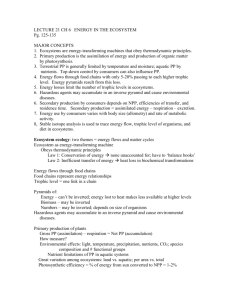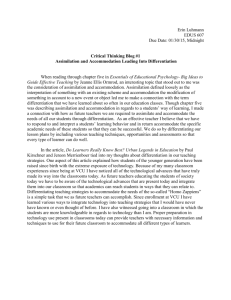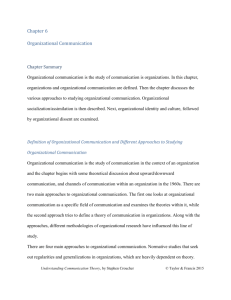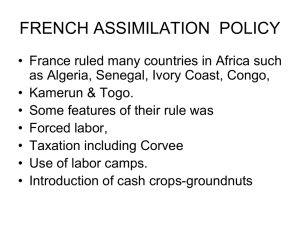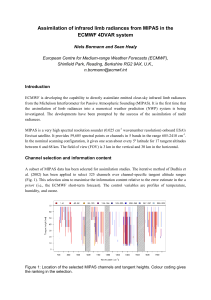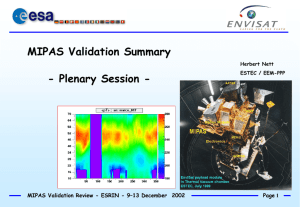MIPAS observations are assimilated using a modified
advertisement
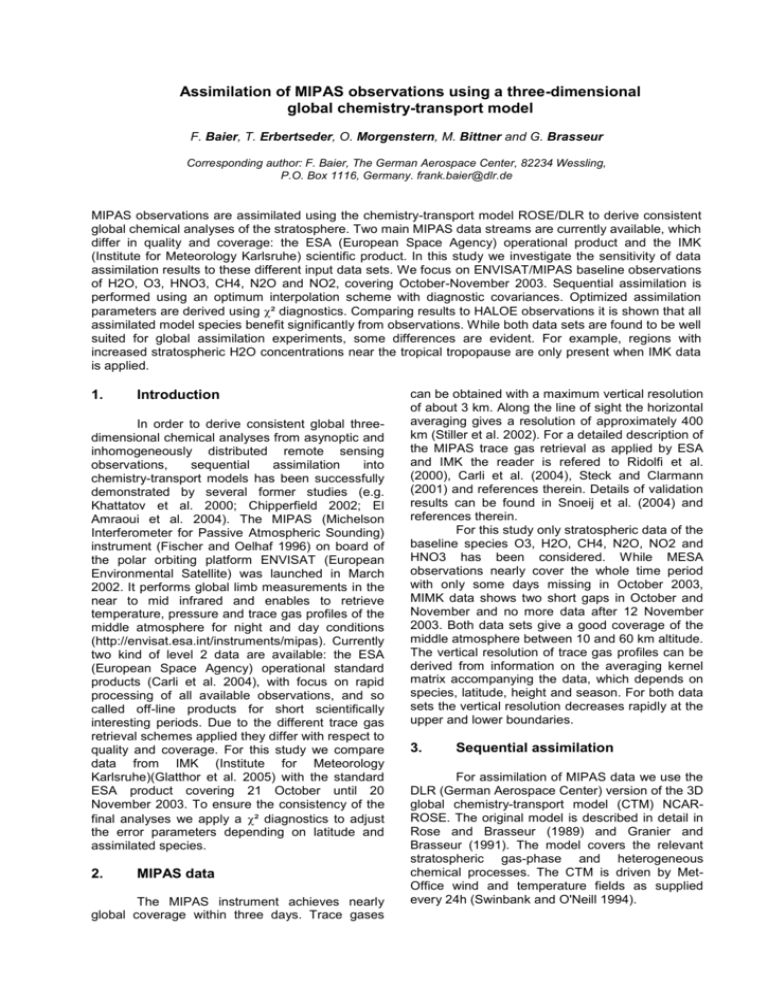
Assimilation of MIPAS observations using a three-dimensional global chemistry-transport model F. Baier, T. Erbertseder, O. Morgenstern, M. Bittner and G. Brasseur Corresponding author: F. Baier, The German Aerospace Center, 82234 Wessling, P.O. Box 1116, Germany. frank.baier@dlr.de MIPAS observations are assimilated using the chemistry-transport model ROSE/DLR to derive consistent global chemical analyses of the stratosphere. Two main MIPAS data streams are currently available, which differ in quality and coverage: the ESA (European Space Agency) operational product and the IMK (Institute for Meteorology Karlsruhe) scientific product. In this study we investigate the sensitivity of data assimilation results to these different input data sets. We focus on ENVISAT/MIPAS baseline observations of H2O, O3, HNO3, CH4, N2O and NO2, covering October-November 2003. Sequential assimilation is performed using an optimum interpolation scheme with diagnostic covariances. Optimized assimilation parameters are derived using ² diagnostics. Comparing results to HALOE observations it is shown that all assimilated model species benefit significantly from observations. While both data sets are found to be well suited for global assimilation experiments, some differences are evident. For example, regions with increased stratospheric H2O concentrations near the tropical tropopause are only present when IMK data is applied. 1. Introduction In order to derive consistent global threedimensional chemical analyses from asynoptic and inhomogeneously distributed remote sensing observations, sequential assimilation into chemistry-transport models has been successfully demonstrated by several former studies (e.g. Khattatov et al. 2000; Chipperfield 2002; El Amraoui et al. 2004). The MIPAS (Michelson Interferometer for Passive Atmospheric Sounding) instrument (Fischer and Oelhaf 1996) on board of the polar orbiting platform ENVISAT (European Environmental Satellite) was launched in March 2002. It performs global limb measurements in the near to mid infrared and enables to retrieve temperature, pressure and trace gas profiles of the middle atmosphere for night and day conditions (http://envisat.esa.int/instruments/mipas). Currently two kind of level 2 data are available: the ESA (European Space Agency) operational standard products (Carli et al. 2004), with focus on rapid processing of all available observations, and so called off-line products for short scientifically interesting periods. Due to the different trace gas retrieval schemes applied they differ with respect to quality and coverage. For this study we compare data from IMK (Institute for Meteorology Karlsruhe)(Glatthor et al. 2005) with the standard ESA product covering 21 October until 20 November 2003. To ensure the consistency of the final analyses we apply a ² diagnostics to adjust the error parameters depending on latitude and assimilated species. 2. MIPAS data The MIPAS instrument achieves nearly global coverage within three days. Trace gases can be obtained with a maximum vertical resolution of about 3 km. Along the line of sight the horizontal averaging gives a resolution of approximately 400 km (Stiller et al. 2002). For a detailed description of the MIPAS trace gas retrieval as applied by ESA and IMK the reader is refered to Ridolfi et al. (2000), Carli et al. (2004), Steck and Clarmann (2001) and references therein. Details of validation results can be found in Snoeij et al. (2004) and references therein. For this study only stratospheric data of the baseline species O3, H2O, CH4, N2O, NO2 and HNO3 has been considered. While MESA observations nearly cover the whole time period with only some days missing in October 2003, MIMK data shows two short gaps in October and November and no more data after 12 November 2003. Both data sets give a good coverage of the middle atmosphere between 10 and 60 km altitude. The vertical resolution of trace gas profiles can be derived from information on the averaging kernel matrix accompanying the data, which depends on species, latitude, height and season. For both data sets the vertical resolution decreases rapidly at the upper and lower boundaries. 3. Sequential assimilation For assimilation of MIPAS data we use the DLR (German Aerospace Center) version of the 3D global chemistry-transport model (CTM) NCARROSE. The original model is described in detail in Rose and Brasseur (1989) and Granier and Brasseur (1991). The model covers the relevant stratospheric gas-phase and heterogeneous chemical processes. The CTM is driven by MetOffice wind and temperature fields as supplied every 24h (Swinbank and O'Neill 1994). We use a similar sequential assimilation scheme as Khattatov et al. (2000). The analysis variances (diagonal part of covariances) are transported as quasi-tracers. In this way the influence of observations on the results is taken into account. The correlation part of background covariances is parameterized by Gaussian functions depending on the local Euclidian gridpoint distances. Global mean ² values are calculated from OMF (observation minus first-guess) values and apriori errors to check the consistency of assimilation parameters and tune model error growth rates and representativeness errors. Using the same settings as Khattatov et al. (2000) resulting ² values were found much too high. Therefore, the representativeness errors were adjusted by using latitudinal dependent temporal mean ² values from a first assimilation experiment as correction factors for each species. Figure (1) shows the resulting corrected representativeness errors. Relatively high values are found for MESA and MIMK HNO3 in the subtropics and high latitudes. Respective N2O errors show maximum values in the tropics and high southern latitudes. For NO2 a strong increase of representativeness errors is derived for high Northern latitudes which is especially significant in the case of MIMK data. This increase of NO2 errors can be related to the solar proton events in late October and early November 2003 (Degenstein et al. 2005). Figure 1: Mean relative representativeness errors derived for MESA (left frame) and MIMK (right frame) data sets. 6. Results For an independent comparison of results HALOE version 19 data for October and November 2003 (http://haloedata.larc.nasa.gov) were used. Observations are limited to the middle northern latitudes and two latitude bands near 70°S and 30°S. Approximately a total of two weeks is covered by observations in October and again in November 2003. Only data above the tropopause (defined by 2 PVU) was considered. Maximum errors are found for NOx for both MIMK and MESA assimilation experiments. With the exception of HCl (not assimilated), relative improvements compared to the base run (no assimilation) reach 40%. Figure 2: Zonal mean analyses (top) and analysis errors (bottom) for MESA (left) and MIMK (right) H2O for 5 November 2003. The 2 PVU isoline (dashed) indicates the tropopause. The vertical axes show the altitude as pressure levels in hPa. The differences of the zonal mean distributions of assimilated species with respect to MESA and MIMK input data are small in general, except for two regions with increased H2O mixing ratios near the tropical tropopause. These are only visible when MIMK data is assimilated. Figure (2) shows the respective H2O distributions for 5 November 2003 using MIMK and MESA. Concerning analysis errors, differences between MESA and MIMK are in general only significant in regions with different data coverage. Minimum relative error values are found between 60 and 1 hPa, while errors increase strongly where no observations are available. For H2O, CH4 and O3, this is mainly true for the troposphere and the tropopause region. For the same reason, HNO3, N2O and NO2 analysis errors increase considerably in the upper stratosphere and lower mesosphere. MIMK analyses of H2O show also a strong increase of analysis errors above 1 hPa. Acknowledgements: This extended abstract shows results of a fulllength paper accepted for publication in a coming up special issue of the Quaterly Journal of the Royal Met. Soc. We would like to thank ESA for providing the MIPAS Level 2 data within the ESA-AO project EVIVA. We are grateful to the Institute of Meteorology, Karlsruhe, for supply of MIPAS IMK data. Further, we thank the German Ministry for Education and Research for funding HGF-ENVISAT. The UK Meteorological Office and the HALOE team kindly provided the meteorological data. References: El Amraoui, L., Ricaud, P., Urban, J., Théodore, B., Hauchecorne, A., Lauti, De La Noë, N., J., Guirlet, M., Le Flocjmoën, E., Murtagh, D., Dupuy, E., Frisk, U. and d'Andon, O. F.: Assimilation of Odin/SMR O3 and N2O measurements in a three-dimensional chemistry transport model. J. Geophys. Res., 109, D22304, doi: 10.1029/2004JD004796, 2004. Brasseur, G., Hitchman, M.H., Walters, S., Dymek, M., Falise, E. and Pirre, M.: An interactive chemical dynamical radiative two-dimensional model of the middle atmosphere. J. Geophys. Res., 95, 5639-5655, 1995. Carli, B., Alpaslan, D., Carlotti, M., Castelli, E., Ceccherini, S., Dinelli, B. M.,Dudhia, A., Flaud, J. M., Höpfner, M., Jay, V., Magnani, L., Oelhaf, H., Payne, V., Piccolo, C., Prosperi, M., Raspollini, P., Ridolfi, M., Remedios, J. and Spang, R.: First results from MIPAS/ENVISAT with operational Level 2 code. Adv. Space Res., 33, 7, 1012-1019, doi:10.1016/S02731177(03)00584-2, 2004. Chipperfield, M. P., Khattatov, B. V. and Lary, D. J.: Sequential assimilation of stratospheric chemical observations in a three-dimensional model. J. Geophys. Res., 107, D21, 4585, doi: 10.1029/2002JD002110, 2002. Degenstein, D. A., Lloyd, N. D., Bourassa, A. E., Gattinger, R. L. and Llewellyn, E. J.: Observations of mesospheric ozone depletion during the October 28, 2003 solar proton event by OSIRIS. Geophys. Res. Lett., 32, L03S11, doi: 10.1029/2004GL021521, 2005. Fischer, H. and Oelhaf, H.: Remote sensing of vertical profiles of atmospheric trace constituents with MIPAS limb-emission spectra. Appl. Opt., 35, (16), 2787-2796, 1996. Glatthor, N., von Clarmann, T., Fischer, H., Funke, B., Grabowski, U., Höpfner, M., Kellmann, S., Kiefer, M., Linden, A., Milz, M., Steck, S., Stiller, G.P., Mengistu Tsidu, G. and Wang, D.-Y.: Mixing processes during the Antarctic vortex split in September/October 2002 as inferred from source gas and ozone distributions from MIPAS/ENVISAT. J. Atmos. Sci.,62, (3), 787-800, 2005. Granier, C. and Brasseur, G.: Ozone and other trace gases in the Arctic and Antarctic regions: Threedimensional model simulations. J. Geophys. Res., 96, 2995-3011, 1991. Khattatov, B.V., Lamarque, J.-F., Lyjak, L. V., Ménard, R., Levelt, P., Tie, X., Brasseur, G. and Gille, J. C.: Assimilation of sattelite observations of long-lived chemical species in global chemistry transport models. J. Geophys. Res., 105, D23, 29135-29144, 2000. Ridolfi, M., Carli, B., Carlotti, M., von Clarmann, T., Dinelli, B. M., Dudhia, A., Flaud, J. M., Höpfner, M., Morris, P. E., Raspollini, P., Stiller, G. and Wells, R. J.: Optimized forward model and retrieval scheme for MIPAS near-real-time data processing. Applied Optics, 39, 1323-1340, 2000. Rose, K. and Brasseur, G.: A three-dimensional model of chemically active trace species in the middle atmosphere during disturbed winter conditions. J. Geophys. Res., 94, 16387-16403, 1998. Snoeij, P., Koopman, R., Wursteisen, P., Zehner, C. and Attema, E.: The ENVISAT Atmospheric Chemistry Instrument Validation Programme. Proceedings of the Second Workshop on the Atmospheric Chemistry Validation of ENVISAT, Frascati, Italy, 3-7 May 2004. ESA SP-562, August 2004, EGE01PS, 2004. Steck, T. and von Clarmann, T.: Constrained profile retrieval applied to the observation mode of the Michelson Interferometer for Passive Atmospheric Sounding. Applied Optics, 40, 21, 3559-3571, 2001. Stiller, G. P., von Clarmann, T., Funke, B., Glatthor, N., Hase, F., Höpfner, M. and Linden, A.: Sensitivity of trace gas abundances retrievals from infrared limb emission spectra to simplifying approximations in radiative transfer modelling. J. Quant. Spectr. & Rad. Transfer, 72, 249280, 2002. Swinbank, R. and O'Neill, A.: A stratosphere-troposphere data assimilation system. Mon. Weather Rev., 122, 686702, 1994.


